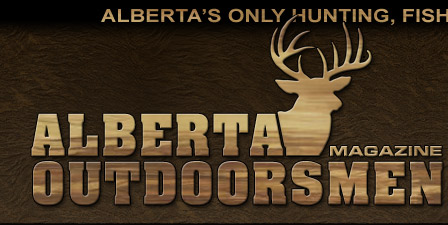 |
 |
| Pierre Frigon |
Gord Trenholm |
 |
I remember long ago browsing my Dad’s “Field & Stream” magazines, reading of incredible moose hunts in the breathtaking remote wilderness of Alaska and the Yukon. The remarkable pictures of giant bull moose had made a long lasting impression on the novice hunter I was, and although only 8 or 9 years of age, I had firmly made up my mind that I would indeed partake in such an adventure as soon as I could.
Over two decades passed before such an opportunity arose. At last, long time hunting partner Gord Trenholm and I were invited to join in on two consecutive annual 10 day “fly-in moose hunts” in the remote Cassiar Mountains of northwestern British Columbia. Four giant bulls later, we were both hooked for life.
We have since had the good fortune of a further eight consecutive “fly-in” moose hunting adventures to northern Alberta resulting in seven monster bull moose, some weighing in at over 1500 pounds (estimated live weight) and sporting racks in excess of 56-inches wide. I can also brag about passing on a few more giant bull moose.
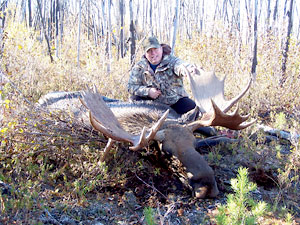 |
| You can expect to hunt Alberta`s largest bull moose on the Canadian Shield. - photo Gord Trenholm |
The most appealing part of fly-in hunts – at least for me – is the exhilaration and almost exotic feeling one experiences when stepping out onto the floats after landing on a remote northern lake, where no man has been before you. You can immediately observe Mother Nature behaving as she has for thousands of years, almost oblivious of your presence. Just imagine for a second… no other hunters, no oil rigs, no cut lines, no quads – nothing but you, pristine wilderness and big mature bull moose! This is why Gord and I are so passionate about fly-in hunts!
Following are a few points to consider when preparing for your very own fly-in hunt:
WHERE TO GO
I don’t think I will surprise anyone by stating that very little of Alberta remains untouched by oil and gas exploration, mining activity or lumber harvest. However, there are still a few select areas remaining that are reasonably productive in terms of fly-in moose hunts. These areas are almost all concentrated across the very northern part of the province, and although low in actual moose densities, most bulls found will indeed be big mature bulls. These areas include:
- The Birch Mountains (north west of Fort McMurray).
- The northeastern corner of the province nestled between Wood Buffalo National Park and Saskatchewan, to the north of Lake Athabasca.
- The Caribou Mountains area, north east of Fort Vermillion.
- The extreme north west corner of Alberta.
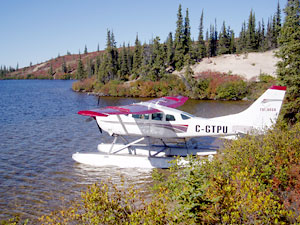 |
| There are few places on earth as remote as the Canadian Shield in Alberta`s far north. - photo Gord Trenholm |
In all cases, you require to do some serious research on the area you are considering. I would first recommend contacting the department of Sustainable Resource Development, Fish & Wildlife Division, and request to speak to biologist(s) involved in the most recent northern Alberta aerial moose surveys. You will be provided with incredibly valuable statistics and data.
You will also want to contact local Fish and Wildlife Officers responsible for the geographical area you are considering. The information provided by these individuals is essential and crucial to establishing hunting / harvest potential, not to mention hunting outfitter activity.
You will need to establish if this area is served by a reliable float plane charter service. Another amazing source of information is the bush pilots. Call the charter service and ask to speak to pilots who regularly fly over the area you are targeting. Once again, you will be amazed at the valuable information these daring individuals can provide.
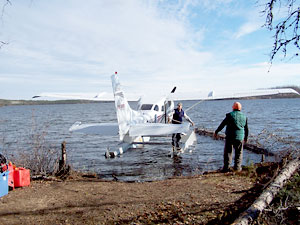 |
The type of floatplane you hire will detemine how many trips will have to be made getting your gear in and out.
- photo Gord Trenholm |
Note that you should allow a minimum of seven days for a fly-in hunt with ten to twelve days being of preference.
FLOATPLANE TYPES
Remember the key words here: “Fly-In Hunt”. This does mean restricted weight and restricted bulk space. The type of floatplane available will very much impact how much gear you can consider bringing. Approximate payloads are as follows:
- Cessnas 180 & 185’s are fairly small and will often require several trips to get all of your gear in as their payloads are restricted to about 500-pounds plus pilot.
- Cessnas 206 can take considerably more with a payload in the range of 850-pounds plus pilot.
- DeHavilland Beavers are at the top of this game with a payload of 1000-pounds plus pilot.
- Otters and Cessna Caravans will usually handle just about anything you can throw at them, but it will come at a cost.
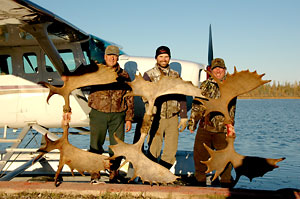 |
Requesting a fly-over of your lake will often increase your chances of coming home with big bull moose.
- photo Gord Trenholm |
*Be sure to enquire about prepayments, deposits, cancellations, maximum weight capacities, external loads, familiarity to the body of water you have selected, and charter company procedures for bad weather scenarios.
*With a bit of luck – you may convince the charter float plane outfit to fly over your planned destination previously whilst on their way to or from other destinations, so as to establish potential campsite locations.
*Be sure to request (or demand) a thorough fly over of your lake and immediate surroundings. You may spot good moose habitat from the air, not to mention smaller adjacent water bodies to hunt during windy or bad weather days. You will also clearly see hazardous submerged rocks in the lake, which could be damaging to your boat or canoe.
WHAT TO BRING
Following is a brief list of some absolute essentials for a successful fly in hunt:
- Wall tent – using trees for frame
- Wood burning stove & pipes
- Plates/Bowls/Utensils, etc
- Axe (large & small)
- Portable electric fencing system
- Hand and chain saw plus fuel
- 300-feet of good rope
- Spotting scope & good binos
- Birch moose call & rattling antlers
- Survival kit / blankets
- Folding chairs / folding table
- Lighters and matches
- Red emergency flashing lights
- Life jackets
- Large pot to constantly boil water
- Collapsible shovel
- Empty 20 litre pails (2)
- Canoe or boat
|
- Boat oars or paddles
- Lanterns (Coleman)
- Satellite phone
- Block & tackle
- Water filter system
- Topo map of area
- Frame / meat packs
- Bone saw
- Flashlights
- Spare batteries
- Bug repellent
- BBQ grill
- Waders
- First aid kit
- Two way radios
- Hand sanitizer
- Warm sleeping bag
- Pillow
|
- Cooking gear / pots / pans
- Spare mantles
- Cooking stove (Coleman)
- Game bags
- Hammer & nails
- Fishing gear
- Fire starter fluid / Wax paper
- Boning knives
- Dry bags (large & small)
- Candles
- Scent remover
- Knife sharpening kit
- Tarps (3)
- Coleman fuel
- Dishwashing supplies
- Paper towels
- Toilet paper
|
You will naturally require the essentials of any hunts, such as the following:
- Rifle & ammo
- Good foot wear
- Snow camo
- Head wear - gloves
- Hunting back pack
- Plenty of food
|
- Hunting knifes
- Warm camo clothes
- Rifle cleaning kit
- Alarm clock
- GPS
- Plenty to drink
|
- Hunting/fishing licences
- Breathable raingear
- Compass
- Cameras (still & video)
- Hygiene kit & towel
- Cards – crib board
|
**Remember one important thing – if you have not got it with you once you board the floatplane, it usually means going without it. Be sure to review your list of essentials several times when packing up before leaving home.
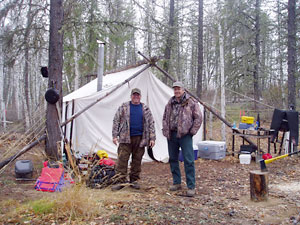 |
| Because you can`t hunt for six hours after landing, getting camp set-up is priority number one. - photo Gord Trenholm |
ONCE YOU GET TO YOUR CAMP AREA
Most bush pilots are right on top of their game and will certainly try getting all of your gear on board and to your destination. As mentioned previously, the size of plane will dictate just how much gear you can take in one load. Be sure to carefully review this with the charter company at the time of booking in order to plan the appropriate amount of flights required and your anticipated charter fees. Take into account that a full mature bull moose will usually account for a return flight of its own, along with a small amount of gear.
Once on location, you will have to unload the plane and start setting up your camp. Since you can`t hunt for six hours after landing, I would advise you do the required tasks, in this order:
- Get the wall tent erected, particularly if you require securing tree poles.
- Set up the inside of your wall tent (cots, wood stove, cooking station, dining table, etc).
- Obtain / chop firewood – minimum three days worth (about one cord).
- Tidy up your camp area and cover anything remaining outside the wall tent with a tarp. Do not leave food items or items that can`t freeze outside the tent
- Set up your electric fence around the perimeter of your camp. Dig up your toilet.
- Set up your meat pole – minimum twenty feet above ground. This usually requires you to first build some type of sturdy ladder, which you can use to both build the meat pole and hang your moose onto it. Note that your meat pole should be within the area covered by the electric fence.
- Get your canoe or boat ready for the next morning hunt!
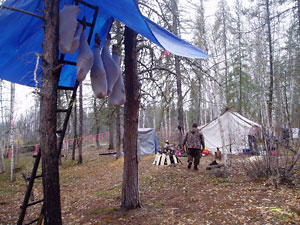 |
Make sure your meat pole is well built and as tall as possible. Notice the electric fence ribboned on left.
- photo Gord Trenholm |
MISCELLANEOUS TIPS
- An electric fence is a proven means to keep bears from raiding and destroying your camp area while you are out hunting. Our set up is very light, we use a portable Gallagher B10 energizer which uses six D cell batteries and produces plenty of pulsating current. We’ve never had a bear in camp since and actually witnessed a huge boar come to camp and willingly avoid the fence line.
- Consider bringing a set of rattling moose horns to complement your calling sessions. Rattling is very productive with large bull moose.
- I would recommend you do a reconnaissance survey of your lake before you physically start hunting. Get familiar with the shoreline and its potential hazards.
- You may wish to hang your food containers on the meat pole if you encounter bear activity.
- Consider cooking all highly odorous food items such as bacon, fish, sausages, etc, outside the tent rather than in the tent.
- Build yourself a nice outdoor fire pit where you can BBQ dinner over natural coals. This will lessen the amount of dishes to be cleaned and leaves all strong smells outside your tent.
- Last but not least, consider building a much needed sauna. All you need is a large tarp, several large rocks (from the immediate surroundings), a wood frame and a long handle shovel.
|
